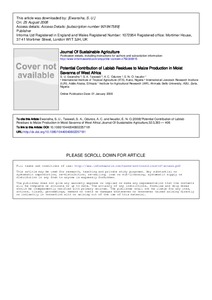| dc.contributor.author | Ewansiha, S.U. |
| dc.contributor.author | Tarawali, Shirley A. |
| dc.contributor.author | Odunze, A. |
| dc.contributor.author | Iwuafor, E. |
| dc.date.accessioned | 2019-12-04T11:15:04Z |
| dc.date.available | 2019-12-04T11:15:04Z |
| dc.date.issued | 2008 |
| dc.identifier.citation | Ewansiha, S.U., Tarawali, S., Odunze, A. & Iwuafor, E. (2008). Potential contribution of lablab residues to maize production in moist savanna of West Africa. Journal of Sustainable Agriculture, 32(3), 393-406. |
| dc.identifier.issn | 1044-0046 |
| dc.identifier.uri | https://hdl.handle.net/20.500.12478/2909 |
| dc.description | Published online: 01 Jan 2008 |
| dc.description.abstract | Soils of the moist savanna of West Africa are poor in
nitrogen; the natural fallow regeneration time has shortened; fertilizer costs
and scarcity makes nitrogen (N) fertilizer input inadequate; and crop yields
are low. In the region, lablab (Lablab purpureus L., sweet also known as
Dolichos lablab L.) has the potential to improve soil quality, provide food,
and supply feed simultaneously. In this context, response of maize to N following
natural fallow or lablab fallow was investigated in the northern
Guinea savanna of Nigeria. Lablab plots were maintained for 2 years—first planted in 2000 and replanted in 2001. In 2001, at the beginning of the
growing season and before planting, lablab residues on the plots from 2000
planting were incorporated. In 2002, prior to maize planting, lablab
residues on the plots from 2001 planting were also incorporated. Similarly,
vegetation on the fallow plots was incorporated. The natural fallow and six
lablab accessions of different maturity group formed the main plots with
0 and 60 kg/ha N as subplots in a split plot design with three replicates.
Maize (Oba Super 1) in lablab plots grew taller and produced more stover
and grain yields than natural fallow. With 0 kg/ha N, maize grain yield
from lablab plots was 6.0 t/ha, 57% higher than from natural fallow. Where
60 kg/ha N was applied, maize mean grain yield from lablab plots was
6.6 t/ha, 31% more than from natural fallow plot. Thus, adding N fertilizer
to plots formerly grown to lablab enhanced the productivity of subsequent
maize. The study showed that late maturing lablab would contribute more
to maize production than early maturing lablab when lablab residues are
incorporated; without N fertilizer input it would be possible to obtain up to
the potential yield of maize with incorporated lablab residues. |
| dc.description.sponsorship | Federal Ministry for Economic Cooperation and Development, Germany |
| dc.language.iso | en |
| dc.subject | Fodder |
| dc.subject | Lablab Residue |
| dc.subject | Maize Grain |
| dc.subject | Maize Stover |
| dc.subject | Natural Fallow |
| dc.subject | N Fertilizer |
| dc.subject | Savanna |
| dc.title | Potential contribution of lablab residues to maize production in moist savanna of West Africa |
| dc.type | Journal Article |
| dc.description.version | Peer Review |
| cg.contributor.affiliation | International Institute of Tropical Agriculture |
| cg.contributor.affiliation | International Livestock Research Institute |
| cg.contributor.affiliation | Ahmadu Bello University |
| cg.coverage.region | Africa |
| cg.coverage.region | West Africa |
| cg.coverage.region | East Africa |
| cg.coverage.country | Nigeria |
| cg.coverage.country | Ethiopia |
| cg.isijournal | ISI Journal |
| cg.authorship.types | CGIAR and developing country institute |
| cg.iitasubject | Soil Information |
| cg.iitasubject | Food Security |
| cg.iitasubject | Crop Systems |
| cg.iitasubject | Disease Control |
| cg.iitasubject | Domestic Trade |
| cg.iitasubject | Food Science |
| cg.iitasubject | Handling, Transport, Storage And Protection Of Agricultural Products |
| cg.iitasubject | Livelihoods |
| cg.iitasubject | Nutrition |
| cg.iitasubject | Soil Fertility |
| cg.iitasubject | Soil Health |
| cg.accessibilitystatus | Limited Access |
| local.dspaceid | 94010 |
| cg.identifier.doi | https://dx.doi.org/10.1080/10440040802257181 |

